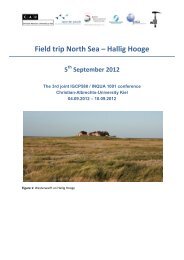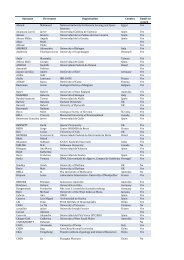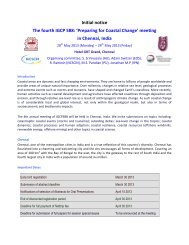Conference program and abstracts - Coastal-Change.Org
Conference program and abstracts - Coastal-Change.Org
Conference program and abstracts - Coastal-Change.Org
You also want an ePaper? Increase the reach of your titles
YUMPU automatically turns print PDFs into web optimized ePapers that Google loves.
The <strong>Coastal</strong> <strong>and</strong> Marine Tourism of East coast of India:<br />
Implications to Environmental Impact<br />
Jayaraju .N., <strong>and</strong> Sreenivasulu , G.,<br />
Department of Geology Yogi Vemana University, Kadapa- 516 003, India<br />
, e-mail: nadimikeri@gmail.com<br />
ABSTRACT<br />
Marine <strong>and</strong> coastal tourism is one of the fastest growing areas within the<br />
world's largest industry. Yet despite increased awareness of the economic<br />
<strong>and</strong> environmental significance of marine <strong>and</strong> coastal tourism it is only in<br />
recent years that a substantial body of research has emerged. Marine<br />
tourism has surfaced as a pressing topic in the field of ocean <strong>and</strong> coastal<br />
management. In fact , the tourism industry has become the largest<br />
business on earth with our boarders. <strong>Coastal</strong> tourism development has<br />
often insufficiently understood the coastal environment. The tourism<br />
experience provides valuable lessons for coastal zone management: the<br />
necessity for Environmental Impact Assessment, management of<br />
increasing tourist numbers, evaluation of small-scale resort development,<br />
consideration of conservation, defining <strong>and</strong> revising planning st<strong>and</strong>ards,<br />
<strong>and</strong> aiming for sustainable development.. The ability of coastlines to<br />
absorb tourism is not limitless. The coast has a certain carrying capacity, a<br />
level of tourist development or recreational activity beyond which the<br />
environment is degraded (environmental carrying capacity), facilities<br />
saturated (physical carrying capacity), or visitor enjoyment diminished<br />
(perceptual or social carrying capacity). India has a coast line of<br />
7,516kms of which the East coast is approximately 4000 km long <strong>and</strong> has a<br />
continental shelf of approximately 6860 km². It is famous worldwide for its<br />
high biological diversity. India's East Coast marine <strong>and</strong> coastal resources<br />
are subject to increasing environmental impacts from coastal tourism,<br />
including overuse or over harvesting of resources, sewage <strong>and</strong> oil<br />
pollution, diminishing fresh water supply, solid waste pollution,<br />
deforestation, declining energy supplies, air pollution <strong>and</strong> siltation. The<br />
article traces the growth of tourism in India, reviews industry trends,<br />
assesses the economic impacts <strong>and</strong> discusses environmental impacts. A<br />
broad ranging series of recommendations to improve conditions in such<br />
areas as drinking water, sewage, beach erosion, energy, education <strong>and</strong><br />
training, research <strong>and</strong> hotel development are listed. Many authorities are<br />
now looking at ways of guiding future tourist growth so as to avoid the<br />
environmental, economic <strong>and</strong> other problems which have emerged in<br />
the past. The present paper gives insights in to the coastal tourism with<br />
some possible recommendation for the sustainable development of this<br />
growing sector.<br />
The Fourth IGCP 588: PREPARING FOR COASTAL CHANGE 29





